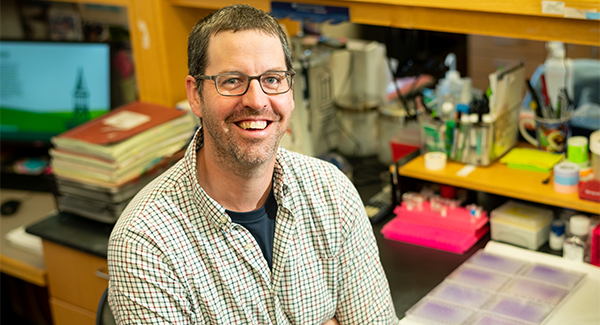Linked to occupational asbestos exposure, malignant mesothelioma (MM) is an aggressive cancer arising primarily from the outer lining of the lungs with a dismal five-year survival rate of only five to 10 percent. Since 2004, only two therapies have been approved for the treatment of MM, which affects about 3,000 people a year in the United States. Now a promising new therapy for mesothelioma and metastatic cancer, arising from laboratory investigations at the University of Vermont, is about to enter a Phase I clinical trial.

Brian Cunniff, Ph.D. (Photo: Andy Duback)
Linked to occupational asbestos exposure, malignant mesothelioma (MM) is an aggressive cancer arising primarily from the outer lining of the lungs with a dismal five-year survival rate of only five to 10 percent. Since 2004, only two therapies have been approved for the treatment of MM, which affects about 3,000 people a year in the United States.
Now a promising new therapy for mesothelioma and metastatic cancer, arising from laboratory investigations at the University of Vermont, is about to enter a Phase I clinical trial.
Bringing scientific discovery to a clinical trial is challenging. According to Dr. Randall Holcombe, director of the University of Vermont Cancer Center, “It takes about 20 years from discovery to clinical trials, and even then, only about 1% of potential new agents achieve FDA approval.”
To be in that 1%, you need solid science and formidable funding. Dr. Brian Cunniff, a faculty member in UVM’s Larner College of Medicine’s Pathology and Laboratory Medicine Department, identified the new therapeutic approach as a Ph.D. student in partnership with his advisor, Emeriti Professor Dr. Nicholas Heintz, and UVM Alumni Dr. Kheng (Newick) Bekdache.
They all knew the research was compelling. The approach,
published in PLOS ONE, targeted a universal vulnerability in cancer cells that could be exploited therapeutically. “All tumor cells are very reliant on efficient waste management systems to grow and survive; we were interfering with that,” said Dr. Cunniff.
Ample funding soon followed this pioneering discovery. Dr. Cunniff was wrapping up his post-doctoral work at Harvard Medical School and making plans to leave academia when he received a phone call from Dr. Heintz that changed his life. The pharmaceutical company RS Oncology, Dr. Heintz said, wanted to fund a cure for MM and had selected their research as the vehicle to do that.
Dr. Cunniff returned to the UVM Cancer Center to continue the work, targeting it to mesothelioma. RS Oncology committed substantial funding to UVM for the comprehensive pre-clinical package, helping the researchers surmount the huge financial hurdle for bringing scientific findings from the bench to the bedside.
“We were excited for the chance to recruit Brian back to our department and support his efforts with RS Oncology,” said Dr. Debra Leonard, chair of the Department of Pathology and Laboratory Medicine. “Our department puts great value in the research conducted by our investigators and seeing that translate to patient treatments doesn’t happen that often.”
Choke on Exhaust
Over the last four-and-a-half years, Dr. Cunniff and his research team, in collaboration with Wake Forest School of Medicine and RS Oncology, have been directly responsible for showing the anti-cancer activity of the treatment approach they identified and in developing/testing a suitable formulation for delivery to humans.
“The drug takes away the ability of cells to metabolize toxic byproducts, so they essentially choke on their own exhaust,” Dr. Cunniff said.
This will be a “first in human” trial to test the safety and activity of this novel approach in MM patients and will be subsequently considered as a targeted therapy for other cancers as well.
The clinical trial will launch in England in late 2021, and the Cunniff Lab at the University of Vermont Cancer Center will serve as a primary site for translational research utilizing patient samples.
And there is reason to be hopeful, Dr. Cunniff said. “There’s significant data in pre-clinical models that indicate this approach could have broad applicability to many cancer types. Until we have sufficient data from the phase 1 clinical trial, it will be difficult to fully understand the possibilities of this approach, although there is considerable optimism.”
“This is what a cancer center is all about, bringing discovery from the laboratory into clinical trials where it can positively impact patients,” Dr. Holcombe said.
About the University of Vermont Cancer Center
The University of Vermont Cancer Center is Vermont’s only not-for-profit comprehensive clinical and research cancer center. Founded in 1974, the organization is located within the University of Vermont Larner College of Medicine and enjoys a clinical partnership with the University of Vermont Medical Center. Drawing on the expertise of more than 225 researchers and clinicians at the university and the medical center, the UVM Cancer Center has an ongoing commitment to innovative cancer research, life-saving prevention and treatment programs, ongoing clinical and public education, and reducing the cancer burden in the community.
Cunniff Lab website
Twitter: @CunniffLab